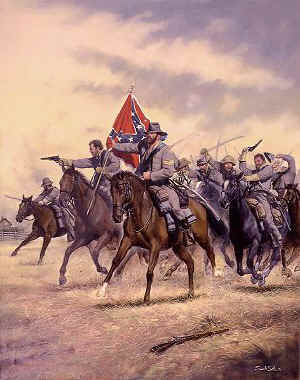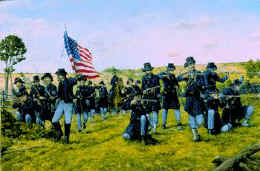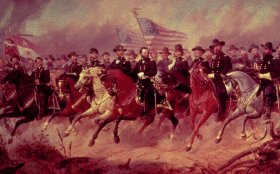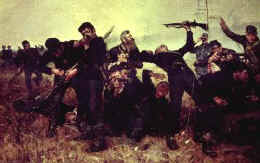|
|
||||||||||||||||||||||||||||||||||||||||||||||
|
||||||||||||||||||||||||||||||||||||||||||||||
|
S.H.A.M. (Steve's Horse and Musket) Rules |
||||||||||||||||||||||||||||||||||||||||||||||
|
Version 0.1: 28 June 2003 - Steve Holmes Introduction
The primary objective is
to produce an extremely simple wargame. In pursuit of
simplicity, various facets of traditional wargames have been
abandoned: This simple approach
may not suit all, and may offend some. Game Concepts ArmiesArmies are composed of elements mounted on bases 4cm wide and 3cm deep.Each element is one of 4 types. Command: Army commanders and Divisional Commanders - individual elements Command StructureArmy Commander commands Divisional Commanders, plus Reserve Guns, Horse or Foot (if any). Turn SequenceThe sequence is described in detail later.Movement alternates between sides: Moving side are active, others are passive.
Move: Active side tests reaction for units wishing to move, successful units may move. Shoot: Passive side shoots, followed by active side. Reaction tests for those taking hits. Charge: Active side tests reaction for units wishing to charge, successful units may charge.
Command Points:
|
||||||||||||||||||||||||||||||||||||||||||||||
|
|
|
|
|
|
|
|
|
|
|
|
|
|
|
|
Commanders may each spend one command point on a single attached unit to add one to all its shoting dice.
Guns firing at 2 rank foot units add 1 to their dice.For each kill on foot and horse, remove an element and place a casualty marker by the unit.
Guns are different, 2 shooting kills in a single turn are required to destroy a gun, single shooting kills are ignored.
After both sides have fired, unit which lost elements during shooting test reaction, units which fail run away.
 Charge:
Charge:
Phasing foot and horse units which are up to 6cm from an enemy target may attempt to charge.
Test reaction. If successful they charge home, if not they stay in position.
After phasing units have tested to charge, non-phasing foot and horse units may also attempt to charge.Foot may not charge horse.
Guns may not charge.
Fight:
Resolve fights between units in combat.
Front rank elements roll d6 and consult the table to determine the score required to cause a kill.
Commanders may spend one command point one one attached unit to to add one to all its fighting dice.
|
|
|||
|
|
Guns |
Horse |
Single Rank Foot |
2 Rank Foot |
Guns |
- |
6 |
6 |
6 |
Horse |
4,5,6 |
5,6 |
5,6 |
6 |
Single Rank Foot |
5,6 |
6 |
5,6 |
5,6 |
2 Rank Foot |
5,6 |
5,6 |
4,5,6 |
4,5,6 |
Losers of hand to hand (Suffered more kills than they caused) now test reaction and run if they fail.
If losers stand, then winners must test reaction and run if they fail.
If both sides stand, then losers withdraw 3cm still facing their enemy.Horse which cause foot to run or withdraw may pursue.
Pursuing horse remain in contact, and avoid the need to test for movement or charge next turn.



 Shoot:
Shoot: